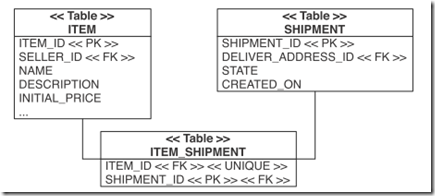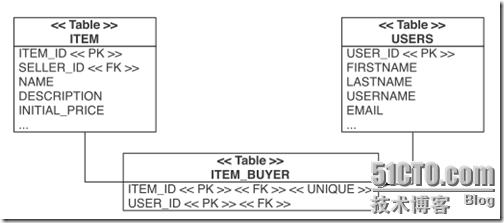inverse:
example:
<class
name="Item"
table="ITEM">
...
<set name="bids"
inverse="true">
<key column="ITEM_ID"/>
<one-to-many class="Bid"/>
</set>
</class>
It’s a hint that tells Hibernate you mapped the same foreign key
column twice.
If you only call anItem.getBids().add(bid), no changes are made persistent!
You get what you want only if the other side, aBid.setItem(anItem), is set correctly.
==============================
cascade:
cascading is used as a convenience feature.
下面这个例子有两个session.save
Item newItem = new Item(x);
Bid newBid = new Bid();
newItem.addBid(newBid); // Set both sides of the association
session.save(newItem);
session.save(newBid);
可以用cascading简化:
<class
name="Item"
table="ITEM">
...
<set name="bids"
inverse="true"
cascade="save-update">
<key column="ITEM_ID"/>
<one-to-many class="Bid"/>
</set>
</class>
第七章:
7.1 Single-valued entity associations
7.1.1 shared primary key association:
user class:
<one-to-one name="shippingAddress"
class="Address"
cascade="save-update"/>
address class:
<class name="Address" table="ADDRESS">
<id name="id" column="ADDRESS_ID">
<generator class="foreign">
<param name="property">user</param>
</generator>
</id>
...
<one-to-one name="user"
class="User"
constrained="true"/>
</class>
This mapping not only makes the association bidirectional, but also, with constrained="true", adds a foreign key constraint linking the primary key of the ADDRESS table to the primary key of the USERS table.
7.1.2 One-to-one foreign key association
<class name="User" table="USERS">
<many-to-one name="shippingAddress"
class="Address"
column="SHIPPING_ADDRESS_ID"
cascade="save-update"
unique="true"/>
</class>
解释为什么是many-to-one 而不是one-to-one:
The mapping element in XML for this association is <many-to-one>—not <one-
to-one>, as you might have expected. The reason is simple: You don’t care what’s
on the target side of the association, so you can treat it like a to-one association
without the many part.
<one-to-one name="user"
class="User"
property-ref="shippingAddress"/>
You tell Hibernate that the user property of the Address class is the inverse of a property on the other side of the association.
7.1.3 Mapping with a join table:
这往往是用在optional link的case上,比如Person and Desk的例子。下面这个例子假定: A shipment has an optional link with a single auction item.
public class Shipment {
...
private Item auction;
...
// Getter/setter methods
}
<class name="Shipment" table="SHIPMENT">
<id name="id" column="SHIPMENT_ID">...</id>
...
<join table="ITEM_SHIPMENT" optional="true">
<key column="SHIPMENT_ID"/>
<many-to-one name="auction"
column="ITEM_ID"
not-null="true"
unique="true"/>
</join>
</class>
note:again, 因为是map到foreign key column, 所以用many-to-one, 跟7.1.2的笔记一样
You could map this association bidirectional, with the same technique on the
other side. However, optional one-to-one associations are unidirectional most of
the time.
7.2 Many-valued entity associations
7.2.1 One-to-many associations
considering bags:
Bags have the most efficient performance characteristics of all the collections
you can use for a bidirectional one-to-many entity association
Because a bag doesn’t have to maintain the index of its elements (like a list) or check for duplicate elements (like a set)
Unidirectional and bidirectional lists:
对于List来说,因为有list-index.这个时候如果用普通的inverse=true放在list上,那么在collection的一端(比如bid)上来控制association, 那么list-index没法有值,所以需要在<many-to-one>上做inverse=true. 而<many-to-one>上是没有inverse属性的,所以这样模拟:
<class name="Bid"
table="BID">
...
<many-to-one name="item"
column="ITEM_ID"
class="Item"
not-null="true"
insert="false"
update="false"/>
</class>
这个通常表示read-only
Optional one-To-Many association with a join table:
user:
<set name="boughtItems" table="ITEM_BUYER">
<key column="USER_ID"/>
<many-to-many class="Item"
column="ITEM_ID"
unique="true"/>
</set>
Item:
<join table="ITEM_BUYER"
optional="true"
inverse="true">
<key column="ITEM_ID” unique=”true” not-null="true"/>
<many-to-one name="buyer" column="USER_ID"/>
</join>
转载于:https://blog.51cto.com/vcycyv/409874







 本文详细解析了Hibernate中各种实体关联映射的方式,包括一对一、一对多及多对多关联的实现方法。重点介绍了双向关联的处理技巧以及如何通过级联操作简化代码。此外,还探讨了使用联合键、外键及中间表进行关联映射的具体应用场景。
本文详细解析了Hibernate中各种实体关联映射的方式,包括一对一、一对多及多对多关联的实现方法。重点介绍了双向关联的处理技巧以及如何通过级联操作简化代码。此外,还探讨了使用联合键、外键及中间表进行关联映射的具体应用场景。



















 被折叠的 条评论
为什么被折叠?
被折叠的 条评论
为什么被折叠?








